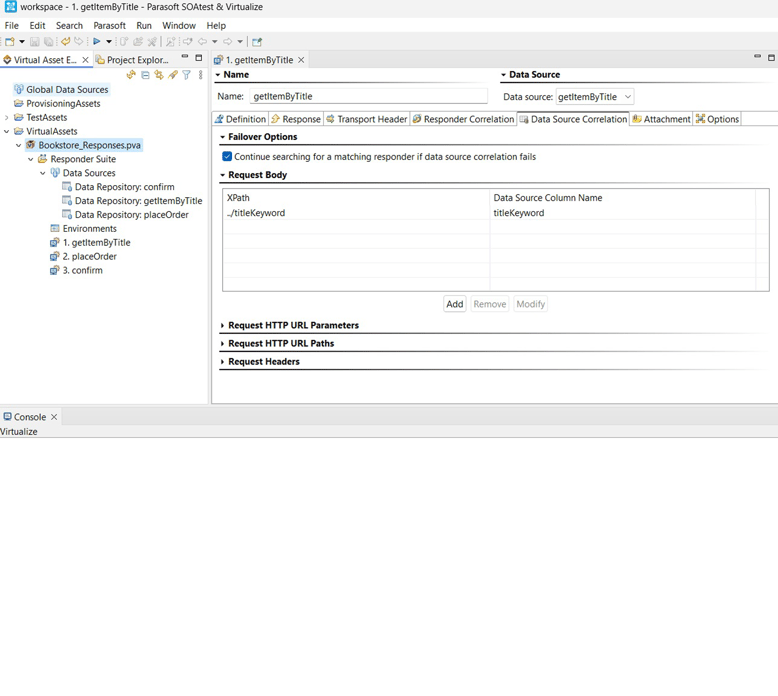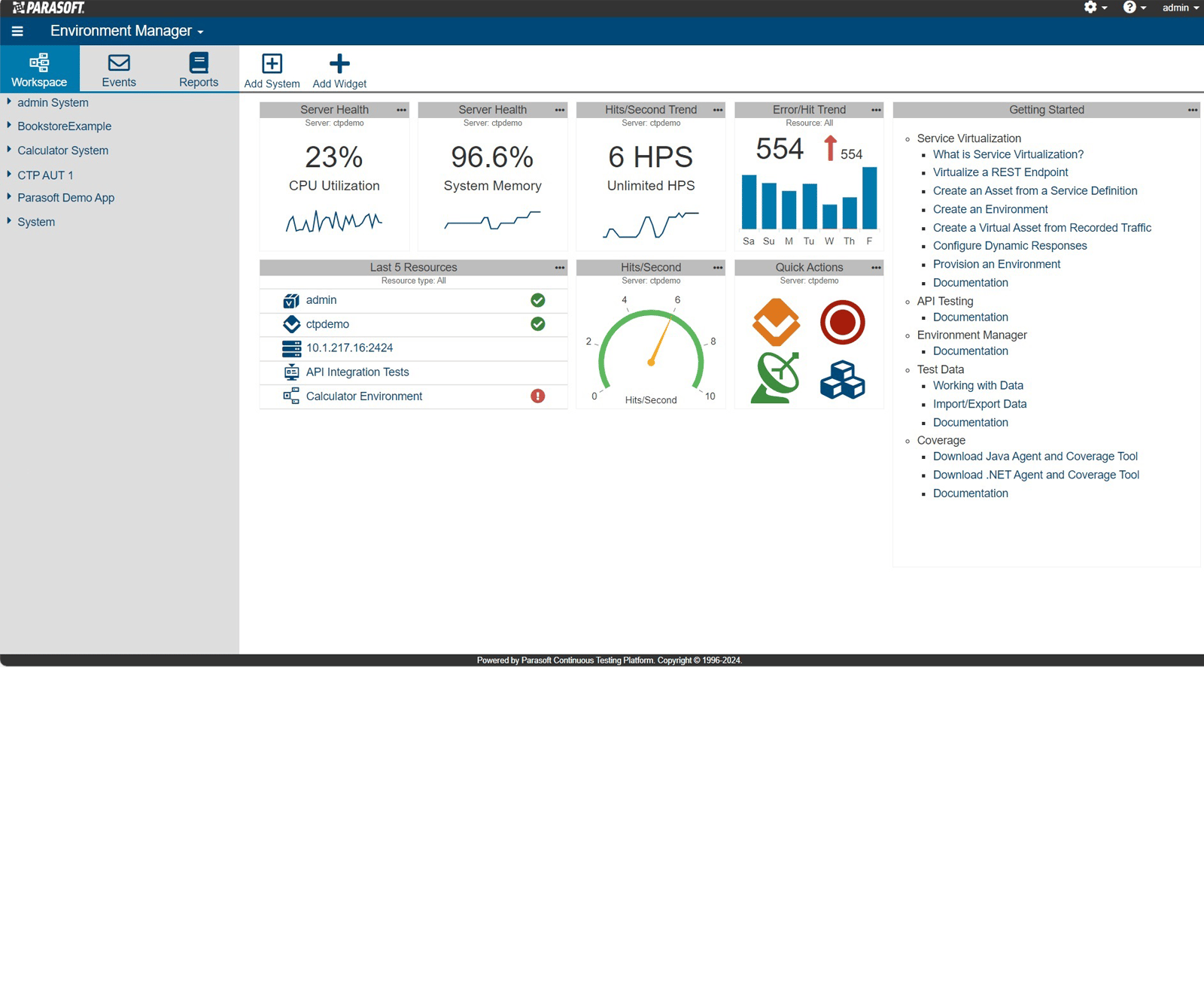Use Agentic AI to generate smarter API tests. In minutes. Learn how >>
Say goodbye to costly testing delays caused by unavailable or constrained dependencies. Embrace the agility to simulate any environment and replicate complex system behaviors for seamless testing without constraints.

Empower teams to overcome the hurdles of unstable test environments and unavailable system dependencies with Parasoft Virtualize. Eliminate testing delays and disruptions by simulating dependent services, enabling comprehensive testing in any scenario, and ensuring your software meets quality standards with confidence.
Conduct testing at any time using service virtualization to replicate unavailable dependencies in the test environment.
Jump to: Virtual Services »
Build realistic simulations of dependent services or systems that behave like the real thing.
Jump to: Simulation »
Simulate unavailable or costly-to-access dependencies, enabling comprehensive testing without expensive external resources.
Jump to: Reduce Costs »
Give teams the power to generate and control their own virtual data to drive higher levels of test velocity and automation.
Jump to: Test Data »
Provide on-demand access to virtual test environments. Simulate diverse system conditions and behaviors to validate application performance.
Jump to: Performance Testing »
Create virtual test environments that can be deployed or destroyed on demand to streamline the testing process.
Jump to: On-Demand Environments »
Implement a virtual service to cover practically every situation. Build reliable and predictable service simulations with broad support for more than 120 message formats and protocols, with no scripting required.
Often, crucial dependent services may be unavailable, not yet developed, or access is limited, posing significant hurdles for automating testing practices. However, service virtualization steps in to mitigate these obstacles. Leverage Parasoft Virtualize to:


“We totally achieved our escaped defect KPI, same with our defect aging goal of no more than seven days to respond to urgent defects. When it comes to our availability, we really are at 99.97%. So, I will say, yes, we achieved and accomplished our goals through a true partnership with Parasoft.”
Roya Montazeri, Senior Director of Quality at Cox Automotive
Capture live system behavior to create realistic virtual services that mimic the actual behavior of service interdependencies. Conduct more thorough testing of application components by covering edge cases and error conditions and testing them with various performance characteristics.
Leverage Parasoft Virtualize to easily and scriptlessly create virtual services from:
Create virtual services that simulate the behavior of dependent services, ensuring comprehensive and accurate testing. Easily control and modify the behavior to enable teams to validate their applications under various conditions, including scenarios that are difficult to reproduce due to behavior complexity like the following:

This empowers teams to increase the thoroughness of testing practices, supporting common service virtualization use cases, edge cases, and error conditions.
Use Virtualize’s learning mode to easily and automatically generate virtual services that are always up to date. Learning mode continuously monitors the actual calls to live services to accurately model requests and responses, and it automatically updates virtual services when the emulated endpoint changes.

Using Parasoft’s virtualization tool to prototype the anticipated behavior of the associated services, the organization can obtain partner feedback on new functionality before it is actually developed—then enable partners to start developing and testing against this functionality the moment it’s approved.
Reduce testing costs with our service virtualization solution, which minimizes testing downtime and the need for costly physical infrastructure and resources by decreasing dependence on external services.
Parasoft Virtualize significantly reduces testing costs in several key ways.


$760,000
Estimated annual savings by automating API testing and implementing service virtualization.
Our test data management solution offers complete autonomy over generating, managing, modifying, and controlling virtual test data, liberating teams from relying on production data. By accelerating data provisioning, it fuels heightened test velocity and automation, fostering efficiency in testing processes.
By giving teams the ability to provision and control the data sets required for testing, our test data management solution eliminates reliance on production data and removes constraints related to data availability, confidentiality, and integrity. Leverage Parasoft Virtualize’s test data management to do the following.

“With Parasoft, we’re able to achieve the goal to create virtualized services from the specifications and generate synthetic data to inject into the services. Before the teams even start development, we have a virtual version of what the API is going to be. From that, we can already start writing tests for it.”
Lead engineer at the large retail and commercial bank
Conduct robust performance testing while slashing costs associated with performance testing environments. Deploy and destroy virtual test environments as needed and ensure thorough performance validation without the need for expensive infrastructure, optimizing resource utilization effectively.
Traditional performance testing often requires an expensive infrastructure to simulate realistic production environments, leading to high operational expenses. Parasoft Virtualize enables teams to create virtualized environments that accurately mimic the behavior of dependent systems, eliminating the need for costly physical infrastructure.
Teams can easily create virtual services that include specific performance characteristics and are optimized for load testing, and then deploy them to Virtualize’s performance server for fast response times and high throughput. By leveraging virtualized environments and ensuring virtual services are optimized for robust load testing, teams can conduct performance testing on demand and at scale without the financial burden of maintaining dedicated test environments.



“We can’t put production loads on certain actual services, but when we’re working with virtual services we can ramp it up with production-level loads and get realistic responses, both in terms of data and performance.”
Frank Jennings, Director TQM Performance Testing at Comcast
Expedite test environment provisioning and start testing earlier with Parasoft Virtualize and CTP. Teams can create and get access to virtual test environments to accelerate the testing process, foster early validation of software functionality, and enhance overall efficiency.
Provisioning a new test environment poses significant challenges, often consuming valuable time and resources. Traditional methods require extensive setup and configuration, leading to delays in testing activities.
With the combination of Parasoft Virtualize and CTP, teams can build virtual test environments that can be swiftly deployed and destroyed on demand in the CI/CD pipeline. By eliminating the time-consuming setup and teardown processes associated with traditional test environments, test environment management enhances agility and responsiveness in testing workflows.
When a live endpoint becomes unstable or unavailable during test execution, automatically switch to testing against the virtual service and mitigate test failures due to environment instabilities and access constraints. Easily provision different environments for different testing scenarios with the relevant test data. This ensures that the application performs as expected during negative testing and when validating common use cases and edge cases.
Read Blog: What Is an “Environment-Based” Approach to Software Testing? »
